 |
|
Kit Shop | Downloads | Links | Site Map | Contact Us |
|
Regimental TraditionsALLIED REGIMENTSThe Queen�s Own Cameron Highlanders - The 79th Cameron Highlanders of Canada formalized the association with the Queen�s Own Cameron Highlanders of the British Army in 1911 becoming officially �Allied� Regiments. The Queen�s Own Highlanders (Seaforth and Camerons) - In 1961 upon amalgamation of the Queen�s Own Cameron Highlanders with the Seaforth Highlanders to form the Queen�s Own Highlanders (Seaforth and Camerons) continuation of the alliance was reaffirmed. The Highlanders (Seaforth, Gordons and Camerons) - In 1994 when the Queen�s Own Highlanders were amalgamated with the Gordon Highlanders to form The Highlanders (Seaforth, Gordons and Camerons), the alliance was again reaffirmed with the new regiment in Scotland. The Highlanders, 4th Battalion The Royal Regiment of Scotland � On 28 March 2006 the six regiments of the Scottish Division were merged into a single, five-battalion regiment titled The Royal Regiment of Scotland. Even prior to the official Formation Day, steps were taken to once again reaffirm the alliance. The Cameron Highlanders of Ottawa - In 1923 the Regiment formed an alliance with the Cameron Highlanders of Ottawa, who had been raised as a rifle regiment in 1881 but converted into a Highland (kilted) regiment in 1920. DRESS
The Blue Hackle � In 1939 the British War Office ordered that the standard battle dress would be worn by all units, abolishing the kilt as the uniform of a highland soldier in battle. When His Majesty King George VI inspected the 1st Battalion, Queen�s Own Cameron Highlanders (of the British Army) in the field on 5 December 1939, the Camerons paraded in kilted order for their Colonel-in-Chief, who was notably impressed. The Commanding Officer, Lieutenant Colonel D.N. Wimberley, suggested that if the regiment was no longer allowed to wear the kilt, it should be at least allowed to wear a white hackle behind the badge in the Balmoral as they had worn with the tropical helmet. The King agreed to the suggestion of wearing the hackle but suggested that as the Camerons were a royal regiment, Royal Blue was more appropriate. Eight hundred hackles were made up and the battalion wore them at Arras for the first time on 11 February 1940.
Upon their arrival in England, The Queen's Own Cameron Highlanders of Canada adopted the blue hackle of their allied regiment. The Blue Hackle was worn sporadically throughout the war, but never officially approved. In 1945 His Majesty George VI approved the right of the Queen�s Own Cameron Highlanders of Canada to wear the Blue Hackle. EVENTSRobbie Burns Dinner � held the closest available Saturday to Robbie's Birthday January 25th, the Robbie Burns Dinner is a mixed dinner hosted by the Warrant Officers and Sergeants and is open to all members of the Regimental Family and guests. The date will be posted on the home page of this site whenever possible to help make it easy to find and track. Church Parade � every year the Regiment holds Church Parade as close as possible to the first Sunday in February to commemorate the raising of the Regiment on 01 February 1910. The Regimental Church is First Presbyterian Church located at 61 Picardy Place in Winnipeg (the corner of Canora Street and Picardy Place � one block South of Portage Avenue on the East side of Vimy Park). St Valentine�s Day Massacre � in 1996 then Lieutenant Dennis Desrochers proposed an all-ranks floor hockey game be held pitting the Junior Ranks (Private to Master Corporal) against the Officers and Senior Non-Commissioned Officers (Sergeants and up). The date chosen for the even was February 14th � Valentine�s Day. The event was a great success and has become an annual event held on the parade night closest to 14 February. Victors: Annual Reunion � each summer the Regiment holds its Annual Reunion on the weekend closest to 19 August to commemorate the Dieppe Raid on 19 August 1942. The reunion weekend generally consists of a meet and greet on Friday night, the Annual Golf Tournament on Saturday, and Church Parade and a farewell luncheon on Sunday. Officer�s Mess Dinner � every year the Officer�s Mess Dinner is held on the weekend closest to 26 October to commemorate Robert Shankland�s winning the Victoria Cross at Bellvue Spur on 26 October 1917. Regimental Christmas Dinner � a custom peculiar to the military is the Christmas tradition of role reversal. The youngest member switches places with the commanding officer for the day, the officers serve dinner to the non-commissioned members and they in turn serve dinner to the stewards. All these activities stem from the ancient Roman custom of Saturnalia. The festival of Saturnalia honors Saturn and falls at the same time as Christmas, Hanukkah, Solstice and/or Kwanzaa. Christmas decorations such as swathes, garlands, wreaths and tree ornaments began with the merriment of Saturnalia. During the time of Saturnalia slaves and children got to be waited on for meals, lead the rituals, and participated in the revelry as if they were their parents/masters. The parents/masters jokingly played the part of children and slaves by waiting on them. The role reversal was symbolic as slaves were not really free to make decisions as free persons nor were children able to enter into contracts or make business deals. Role reversal was only for minor privileges. Before the introduction of mechanization and sophisticated systems of logistics in the 20th century, enlisted personnel occupied much of their time in tedious routine. In an effort to boost morale, and to show general appreciation for junior ranks, officers took it upon themselves to organize celebrations for the enlisted ranks. One tradition that has been preserved over the ages has been Christmas dinner. Officers and senior non-commissioned officers not only organize the dinner, but they also prepare and serve it to the junior ranks of their unit. When the dinner is over their task is not complete until they clean up the cafeteria. On this special occasion, one tradition can be found throughout the Forces during the Christmas season. During these festive times, rules are bent in a playful way. The Commanding Officer switches roles tunics with the youngest member of the unit. This soldier then becomes the honorary commander for the dinner. Each December the Regiment holds its Regimental Christmas Dinner. In addition to serving members, the dinner is attended by former members belonging to the Cameron Association and the Regimental Advisory Board. The dinner is served to the soldiers and guests by the officers and senior non-commissioned officers of the Regiment. After dinner, the Commanding Officer presents any Unit Achievement Awards or Commanding Officer�s Commendations from the year and the Regiment�s Annual Awards are made to the Soldier of the Year, the Top Corporal, and the Russ Miller Memorial �Cameron of the Year�. New Year�s Levee � The Regiment starts each new year bright and early, meeting at the mess New Year�s morning for PeeWees (Scottish meat pies) and Scotch Broth. The Officer�s and Warrant Officers and Sergeants each gather in their respective messes. The two alternate each year in hosting the other for a New Year�s toast. ARTEFACTSThe Colours � the serving stand of Colours are kept in the Officer�s Mess when not on parade. Retired stands of Colours are laid up in the Cameron Chapel at the Regimental Church. 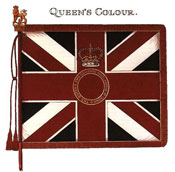 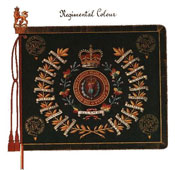 The Geddes Brooch � Captain John Geddes was the first Cameron officer killed in action during the First World War. Serving with Number 3 Company of the 16th Battalion (Canadian Scottish), Captain Geddes fell during the second battle of Ypres on the night of 22-23 April 1915. So well regarded was Geddes by the men of his company, that they commissioned a broach modelled after the Cameron Officer�s crest in precious stones and presented it to his widow. The Geddes Broach is now held by the Regiment, and is loaned to the Commanding Officer�s wife for wear on special Regimental occasions. The Reid Brooch � The J.Y. Reid Brooch is a jewelled version of the 174th Battalion collar badge. Reid was the commanding officer of the 174th and later an Honorary Colonel of the Regiment. The brooch was purchased from the Reid estate by Major Bill Grey on behalf of the Cameron Advisory Board and is designated for wear by the wife of one of the Regiment�s Honoraries. The Senior Subaltern�s Stick - the Senior Subaltern is entitled to carry a blackthorn stick that was brought back from Africa and donated to the Regiment by Major Reid to be used as a symbol of that appointment. The Commanding Officer�s Dirk - when placed on the table in the mess, is a sign that all may speak freely under the CO�s protection. An earlier form of this tradition had the CO�s sgain dubh passed from officer to officer, allowing the holder to speak his mind. This was likely amended as attempts were often made to keep the sgain dubh away from those whose opinions were unpopular. His Nibs � originally a Regimental Shooting Trophy, His Nibs must sit on the head table of any dinner the Commanding Officer presides over. Typically, these are the Officer�s Mess Dinners and the Men�s Christmas Dinner each year. The Quaichs � the two pewter cups used by the CO and the Pipe Major to make the Toast to the Regiment at mess dinners. The Toast to the Regiment is made with neat Scotch Whiskey, each quaich holding three ounces.
OTHER TRADITIONSMotto - The motto of the Regiment is the Gaelic word �Ullamh� which means �Ready� Toast to the Regiment �Pipe Major toasts: �Slainte agus sonas de reiligh an regiment, agus du na cardan acha� Commanding Officer responds: �Slainte du piobar� Toast to Fallen Comrades � the Lament (Flowers of the Forrest) one minute silence 4th verse of Binyon�s For the Fallen: They shall grow not old, as we that are left grow old Age shall not weary them, nor the years condemn. At the going down of the sun and in the morning We will remember them. All reply �We will remember them� Toast: Gentlemen, �To Fallen Comrades� Response: �To Fallen Comrades� Regimental Dinners � Regimental dinners are scheduled 1830 for 1910 to commemorate the Regiment�s raising in 1910. Forms of Address in the Officer�s Mess � in keeping with Highland tradition, all Regimental officers, regardless of rank, address each other by their first names in the mess. The only exception is the Commanding Officer, who is addressed as Colonel by all. 09:36 Cameron Standard Time � back in the summer of 1978 during a Militia Concentration (MILCON) in Dundurn, Saskatchewan H-Hour for the final attack was scheduled for 09:36. The troops had been out patrolling the night before and as 09:36 came and went, the majority of the patrols had not yet returned. H-Hour was repeatedly delayed until finally sometime after noon, the officer in charge proclaimed, �It is now 09:36! Get the attack in!�. For years afterwards, when asked what time it was, members of the regiment would simply reply �09:36� which came to be known as Cameron Standard Time. Company Colours � Authorized Company Colours are as follow:
When the unit is not at full wartime establishment, Company Colours are combined as follows:
|
| � 2006 - The Queen's Own Cameron Highlanders of Canada |

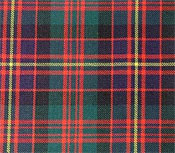 Cameron of Erracht tartan � Tradition has it that when the 79th Foot were raised in 1793, Sir Alan Cameron�s mother, Marsali MacLean created a distinctive tartan for her son�s Regiment. She was the daughter of Ranald McDonnell and based the design on a mixing of the McDonnell and Cameron tartans.
Cameron of Erracht tartan � Tradition has it that when the 79th Foot were raised in 1793, Sir Alan Cameron�s mother, Marsali MacLean created a distinctive tartan for her son�s Regiment. She was the daughter of Ranald McDonnell and based the design on a mixing of the McDonnell and Cameron tartans. 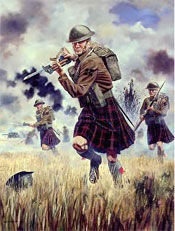 After the Camerons were withdrawn from Dunkirk (still in kilted order and consequently the last battalion to wear the kilt in action) wearing of the royal blue hackle was discontinued pending war office approval. It was finally approved in 1951.
After the Camerons were withdrawn from Dunkirk (still in kilted order and consequently the last battalion to wear the kilt in action) wearing of the royal blue hackle was discontinued pending war office approval. It was finally approved in 1951.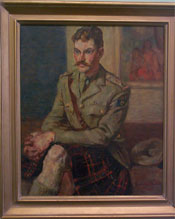 Portrait of Lieutenant S.A. Chopp � commissioned to represent the typical Highland soldier for use as a wartime recruiting poster in Scotland, the portrait was painted in Britain during the Second World War by Jadwiga Walker, a Polish artist who took the painting back to Warsaw with her in 1945. The subject, Lieutenant Stan Chopp of Winnipeg, is reputed to have destroyed a German tank with a PIAT and was killed during the fighting in Normandy. In 1964 the portrait was secured on behalf of the Regiment by Colonel Peter Bingham who came across it while serving as Canadian Military Attach� in Poland. The portrait currently hangs in the Deputy Commanding Officer�s office.
Portrait of Lieutenant S.A. Chopp � commissioned to represent the typical Highland soldier for use as a wartime recruiting poster in Scotland, the portrait was painted in Britain during the Second World War by Jadwiga Walker, a Polish artist who took the painting back to Warsaw with her in 1945. The subject, Lieutenant Stan Chopp of Winnipeg, is reputed to have destroyed a German tank with a PIAT and was killed during the fighting in Normandy. In 1964 the portrait was secured on behalf of the Regiment by Colonel Peter Bingham who came across it while serving as Canadian Military Attach� in Poland. The portrait currently hangs in the Deputy Commanding Officer�s office.